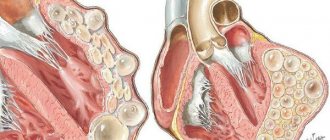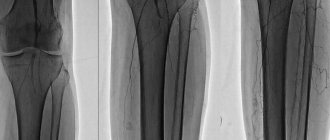Tonsillitis is an inflammation of areas of lymphoid tissue (tonsils) located on the back wall of the pharynx. They protect the body from the penetration of potentially dangerous viruses or bacteria, but in some cases they themselves can become infected. In many acute cases, the disease is viral in nature, so tonsillitis can be treated without the use of antibiotics. The chronic form of the disease is associated with the long-term existence of bacteria in the tonsil tissue. It requires complex therapy, and in some cases, surgical intervention. Tonsillitis most often affects children, but it can develop in people of any age.
Symptoms of tonsillitis
Signs of tonsillitis depend on its form and course. In the simple form, only local symptoms are observed. The toxic-allergic variant is accompanied by damage not only to the tonsils, but also to internal organs. Treatment of this form of chronic tonsillitis should begin as early as possible.
Possible symptoms of tonsillitis:
- sore throat, discomfort when swallowing, in young children food refusal is possible;
- signs of intoxication - fever, headache, weakness;
- redness, swelling of the tonsils, the appearance of white plaque or purulent plugs on them;
- hoarseness, cough, bad breath;
- abdominal pain, nausea and vomiting;
- enlargement and tenderness of the cervical lymph nodes;
- runny nose, red eyes, ear pain.
When the first symptoms of tonsillitis appear, you should consult a doctor, as this disease can become chronic or cause complications in the internal organs.
What other tonsils are there in the pharynx?
Other tonsils that form the lymphoid pharyngeal ring are: adenoid vegetations, or, more simply, adenoids, which are not a paired organ. They are located in the dome of the nasopharynx. It is impossible to see them with the naked eye. In order to recognize the condition of the adenoids, it is necessary to perform an endoscopic examination of the nasopharynx. Inflammation of the adenoids is called adenoiditis and is more common in children.
Also in the pharynx there is a lingual tonsil, located at the root of the tongue, which, like the adenoids, is an unpaired organ.
There are also tubal ridges, which are also called tubal tonsils. They are located at the entrance to the pharyngeal mouth of the auditory tube. The tube ridges are located deep in the nasopharynx, on the lateral (medial) surfaces of the nasopharynx on the right and left. Tubal tonsils perform an important function - they protect against infection entering the auditory tube. Since each of the tonsils of the lymphoepithelial pharyngeal ring deserves separate close attention, in this article we will only talk about the palatine tonsils and chronic tonsillitis. Other tonsils and the pathology they cause will be described in detail separately, in other relevant ENT articles.
Causes
Tonsillitis is an infectious disease. It can be caused by various types of viruses:
- adenovirus, enterovirus, influenza and parainfluenza viruses;
- Epstein-Barr virus, cytomegalovirus infection;
- pathogens of measles, herpes simplex and others.
Bacterial tonsillitis is most often caused by streptococci. It can also be caused by staphylococci, gonococci, corynebacterium diphtheria, anaerobic flora, and spirochetes. Candida sore throat sometimes occurs in young children.
The development of the disease also involves factors that reduce the overall resistance of the body - hypothermia, malnutrition, prolonged emotional stress and others.
Treatment for tonsillitis depends on its causes. To determine the causative agent, timely consultation with a doctor is necessary.
Risk factors
The risk of developing chronic tonsillitis of the throat increases if the patient has a hereditary predisposition to the disease. About 3% of all recorded cases are transmission of the inflammatory process from parents to children. Also, the protracted course of infectious diseases is caused by formations in the nasal cavity, polyps and sinusitis. The source of infection can be a carious tooth, gum disease, or periodontitis. Additionally, the body is weakened by poor nutrition, bad habits, constant stressful situations, and prolonged use of potent drugs.
Classification of tonsillitis
The disease can be acute or chronic. In the first case, signs of infection disappear within 7 to 10 days. In a chronic course, pathogens remain in the tissues of the tonsils, causing periodic exacerbations. Treatment of chronic tonsillitis is a complex task that only experienced otolaryngologists can handle.
Chronic tonsillitis has 2 forms - simple and toxic-allergic. In the latter case, there are 2 degrees of severity of pathological changes.
The simple form is characterized by only local symptoms. With the toxic-allergic variant, the following pathological processes occur:
- microbial toxins that enter the blood cause sensitization (altered reactivity) of the body;
- they act directly on the tissues of internal organs;
- toxins also lead to the development of allergic and autoimmune reactions.
To treat tonsillitis in this case, a complex effect on the entire body is necessary.
Acute form
Sore throat, or acute tonsillitis, begins suddenly with an increase in temperature and the appearance of signs of intoxication. It has several clinical forms:
- catarrhal: redness and swelling of the tonsils, arches, soft palate;
- follicular: round or fuzzy white-yellow dots appear on the surface of the tonsils, caused by inflammation of the lymphoid follicles;
- lacunar: a light coating appears in the recesses of the tonsils, which covers their surface in the form of islands;
- fibrinous: purulent plaque lines the entire surface of the tonsils, an unpleasant odor appears from the patient’s mouth;
- phlegmonous: the formation of purulent foci (abscesses) inside the tonsil, which causes a sharp pain in the throat, the inability to move the head, and deterioration of the general condition.
The development of severe forms of the disease is usually associated with untimely or improper treatment of tonsillitis.
Chronic form of tonsillitis
Chronic tonsillitis is characterized by repeated recurrence of tonsillitis. A long-lasting focus of infection forms in the palatine tonsils. This leads to a deterioration in the general condition:
- the patient experiences a constant or periodic increase in body temperature;
- the patient complains of fatigue, decreased mental and physical performance, sweating;
- Headaches, sleep and appetite disturbances are noted.
In the simple form of the disease, there is redness, enlargement of the tonsils and palatine arches, their fusion, and enlargement of the lymph nodes.
The toxic-allergic form is accompanied by damage to internal organs. In grade I, changes in the general condition, heart, joints, enlarged lymph nodes, and laboratory abnormalities are not constant. II degree of severity is accompanied by the following disorders:
- pain in the heart area, rapid heartbeat, heart rhythm disturbances, changes in the ECG;
- joint pain, which occurs not only during an exacerbation, but also during remission;
- prolonged increase in body temperature to subfebrile levels;
- changes in the functioning of the liver, kidneys and other organs, manifested by corresponding symptoms and changes in laboratory data.
Chronic tonsillitis is part of the pathogenesis of many other diseases - rheumatism, polyarthritis, glomerulonephritis, sepsis, pathology of connective tissue, endocrine, nervous, and digestive systems.
Tonsillectomy
Chronic tonsillitis can be cured. To get rid of it forever, the tonsils are removed. However, the operation is often postponed, justifying the decision by the participation of these formations in the formation of immunity.
In fact, the mass of the tonsils constitutes only 0.05% of the total mass of lymphoid tissue, which mediates the systemic immune response3. The functions of protecting the respiratory tract from microorganisms penetrating through the mouth and nose are taken over by other tonsils3: paired tubal and unpaired lingual and pharyngeal tonsils. Moreover, the tonsils affected by infection lose their functions1 and turn into a focus of infection that can cause serious illnesses.
The operation is performed in a hospital setting. It involves complete bilateral removal of the tonsils along with the surrounding capsule and often does not require general anesthesia5.
Contraindications to it are:
- blood diseases accompanied by a decrease in blood clotting;
- severe cardiovascular, renal, hepatic and pulmonary insufficiency;
- severe course of hypertension;
- heart problems such as cardiosclerosis with angina pectoris5.
The operation should be postponed if it is necessary to treat acute respiratory viral infections and other infections and concomitant diseases, the exacerbation of which is possible as a result of surgical intervention.
Up to contents
Complications of tonsillitis
Tonsillitis, both acute and chronic, can cause local and general complications.
The first group includes damage to the tissues of the pharynx: paratonsillar abscess, parapharyngitis, laryngitis. Local complications also include acute otitis media and cervical lymphadenitis.
Common complications associated with damage to internal organs:
- diseases of the joints and connective tissue: rheumatism, rheumatoid arthritis, infectious polyarthritis, systemic lupus erythematosus;
- damage to the heart and mediastinum: myocarditis with the development of dilated cardiomyopathy and heart failure, mediastinitis;
- inflammation of the lungs, kidneys, appendix, sepsis and others.
To avoid the development of such complications, if there are symptoms of tonsillitis, it is necessary to carry out its full treatment.
Diagnostics
Recognition of acute or chronic forms of the disease is based on the following diagnostic data:
- enlargement and possible soreness of the submandibular and cervical lymph nodes;
- swelling, redness of the tonsils and arches, their inflammatory infiltration;
- discharge of purulent contents when pressing with a spatula on the surface of the tonsils.
To diagnose lesions of other organs, laboratory tests, ECG, radiography of the paranasal sinuses and other studies are used.
Types of treatment for tonsillitis
Treatment of acute tonsillitis is carried out taking into account its cause. For bacterial sore throat, antibiotics are prescribed. Anti-inflammatory, antipyretic, painkillers, and gargling with antiseptic solutions are used.
Treatment of chronic tonsillitis includes external therapy, tonsil lavage, physiotherapy, and surgery.
Treating tonsillitis at home
During the period of remission of the disease, the following means can be used to mechanically remove pathogens and increase the body’s reactivity:
- applying a mixture of aloe juice (1 part) and honey (3 parts) to the tonsils;
- gargling with infusions of medicinal herbs (chamomile, yarrow, St. John's wort, linden blossom, garlic, eucalyptus);
- using propolis in the form of pieces or ingesting a solution of propolis in warm milk.
Drug treatment of tonsillitis
Conservative therapy is prescribed for acute tonsillitis (angina), exacerbation of a chronic process. Antibacterial drugs and symptomatic agents are prescribed.
During the period of remission, courses of washing the tonsils lasting 10 days are indicated 2-3 times a year. Such treatment is carried out using the “Tonsillor” or “Utes” devices. The lacunae are washed with solutions of antiseptics and immunostimulants - interferon, levamisole, lysozyme and others. After washing, the surface of the tonsils is treated with Lugol's solution or collargol.
A course of irradiation with a helium-neon laser or low-intensity incoherent red light, ultraviolet irradiation, ultrasound therapy, UHF and other physiotherapeutic techniques are used.
Such treatment cannot completely relieve the patient of tonsillitis. It only helps to reduce the frequency of exacerbations and reduce the risk of complications of the disease. If conservative methods are ineffective within 1–2 years, surgical intervention is indicated.
Prevention
You can avoid acute tonsillitis in a child or adult if you follow some rules:
- Maintaining immunity through hardening, proper nutrition, normalization of work and rest;
- Avoiding hypothermia in the autumn-winter period;
- Avoiding sudden changes in temperature in summer (air conditioning, cold drinks, ice cream, etc.);
- Taking special immunostimulating agents that activate the body’s local defenses (Imudon®)4.
Secondary prevention, which involves preventing complications of angina, includes compliance with all treatment recommendations3. In addition, taking local immunomodulators that reduce the number of bacteria on the tonsils is encouraged.




